Zara - IPARK Mall Branch [Tax Refund Shop] (자라 아이파크몰)
7.1Km 2024-04-23
55, Hangang-daero 23-gil, Yongsan-gu, Seoul
-
It Michaa [Tax Refund Shop] (잇미샤)
7.1Km 2024-04-19
4F I’Park Mall, 55, Hangang-daero 23-gil, Yongsan-gu, Seoul
-
Hyundai IPARK Mall [Tax Refund Shop] (현대 아이파크몰)
7.1Km 2024-04-18
55, Hangang-daero 23-gil, Yongsan-gu, Seoul
-
IPARK Mall Clinic [Tax Refund Shop] (아이파크몰의원)
7.1Km 2024-04-18
(Hangang-ro 3-ga) I'Park Mall Living Hall 6th floor, 55, Hangang-daero 23-gil, Yongsan-gu, Seoul
-
Chicor - IPARK Mall Branch [Tax Refund Shop] (시코르 용산아이파크)
7.1Km 2024-06-27
3F, 55, Hangang-daero 23-gil, Yongsan-gu, Seoul
-
Olive Young - Yongsan I'Park Mall Branch [Tax Refund Shop] (올리브영 용산아이파크몰점)
7.1Km 2024-06-27
4F, 55, Hangang-daero 23-gil, Yongsan-gu, Seoul
-
The Museum of Medicine (서울대학교병원의학박물관)
7.1Km 2024-03-18
101 Daehak-ro, Jongno-gu, Seoul
The Museum of Medicine is located in the building of the former Daehan Medical Center, the oldest modern hospital in Korea. It is a medical museum that provides a comprehensive view of the development of modern medicine in Korea, the history of medical devices, and the transformation of Seoul National University Hospital. Through permanent and special exhibitions, the museum showcases medical artifacts and documents related to the history of medicine.
Monument Coffee (모뉴먼트커피)
7.1Km 2023-12-22
5 Olympic-ro 62-gil, Gangdong-gu, Seoul
Monument Coffee is a casual hangout café for locals located across from Cheonho-dong. This cafe is on one side of the first floor of the building, and although it is small, with only three or four tables, many regulars visit this place often due to the taste of coffee, baked snacks, and desserts. The signature menu here is the real vanilla bean latte. The unique, savory flavor comes to life thanks to the generous use of vanilla beans. This signature menu is limited and only offered while ingredients last on a daily basis, so visitors are advised to visit early. Baked snacks and desserts that go well with coffee are also available, including financiers, madeleines, churros, and apple pies.
King Sejong The Great Museum (세종대왕박물관)
7.1Km 2024-03-08
56, Hoegi-ro, Dongdaemun-gu, Seoul
+82-2-969-8851
King Sejong The Great Museum is a cultural complex located in the heart of Seoul, near Gwanghwamun Plaza.The Hangeul Room exhibits documents published during the reign of King Sejong, the Science Room displays Cheugugi and celestial planisphere, and the Korean Traditional Music Room showcases various traditional Korean musical instruments. The Biography Room features Portrait of King Sejong and paintings depicting scenes from his life. Outdoors, there are statues of King Sejong, the scahe sundial, the clepsydra, and Cheugugi.
Seoul Daehan Hospital (서울 대한의원)
7.1Km 2021-12-23
101, Daehak-ro, Jongno-gu, Seoul
+82-2-2148-1842
Daehanuiwon (Daehan Medical Center) is an antique two-story brick building within the grounds of Seoul National University Hospital. It was established under the direct administration of the Uijeongbu (State Council), combining the Gwangjewon (under the Home Ministry), Gyeongseong Medical School and the Korean Red Cross Hospital (under the Royal Household).
Built in the Madubong Hill area, this location where Hamchunwon, the outer garden of Changgyeonggung Palace, once stood in 1484 (15th year of King Seongjong), was also once the site of Gyeongmogung Palace, where King Jeongjo enshrined the mortuary tablet of his birth father Crown Prince Sado Seja in 1776 (the year King Jeongjo ascended to the throne).
These places that held importance for the royal family were destroyed as the Japanese built Gyeongseong Empire University in its place. In 1907, with the announcement of the plan to establish Daehan Medical Center, construction began on the main building, seven wards and affiliated buildings. Construction was completed in November 1908.
The Daehan Medical Center opened in Gwangjewon, but upon Japanese colonization in 1910, its name was changed to the Japanese Viceroyalty Hospital. In 1926, it was included as a part of Gyeongseongjeguk University to become a university hospital. Since the liberation of Korea in 1945, it has been a hospital affiliated with Seoul National University.
![Zara - IPARK Mall Branch [Tax Refund Shop] (자라 아이파크몰)](http://tong.visitkorea.or.kr/cms/resource/67/2889867_image2_1.jpg)
![It Michaa [Tax Refund Shop] (잇미샤)](http://tong.visitkorea.or.kr/cms/resource/25/2891025_image2_1.jpg)

![IPARK Mall Clinic [Tax Refund Shop] (아이파크몰의원)](http://tong.visitkorea.or.kr/cms/resource/21/2890621_image2_1.jpg)
![Chicor - IPARK Mall Branch [Tax Refund Shop] (시코르 용산아이파크)](http://tong.visitkorea.or.kr/cms/resource/67/3314267_image2_1.jpg)




 English
English
 한국어
한국어 日本語
日本語 中文(简体)
中文(简体) Deutsch
Deutsch Français
Français Español
Español Русский
Русский